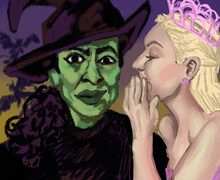In Lockerbie book, professors look past tragedy
Eight of Lawrence Mason’s students died Dec. 21, 1988, when their plane exploded in the sky over Lockerbie, Scotland.
Libyan terrorists planted a bomb in Pan Am Flight 103, and the crash killed 11 people on the ground and all 259 people aboard the plane. Thirty-five were Syracuse University students.
Twelve years and 12 visits to Lockerbie later, Mason, a professor of visual and interactive communications at SU, finished ‘Looking for Lockerbie.’ The book, part of Syracuse University Press’ spring collection, is a 240-page depiction of what Lockerbie is really like. The stories are accompanied by 254 photographs, 100 of them taken by Mason and the rest taken by students.
‘From the moment that plane went down, I knew I’d go to Lockerbie someday,’ Mason said. After his first trip in 1996, he knew Lockerbie was a place he wanted to visit more than just once.
‘When the world thinks of Lockerbie, they think of Pan Am 103,’ Mason said. ‘But when the people of Lockerbie think of their town, they don’t automatically think of the disaster.’
Mason asked Melissa Chessher, chair of the magazine journalism department in the S.I. Newhouse School of Public Communications, for help with writing a grant proposal so he could take more students to Lockerbie.
‘The day he asked me for my help was one of the luckiest days of my life,’ Chessher said.
The purpose of the book is to show how the 4,000 people of Lockerbie actually see their community, apart from just being the place where Pan Am 103 crashed to the ground, Mason said.
Mason, Chessher and the students whose work is featured in the book, came to an agreement that all of the money they would normally receive from the sales should be donated to fund the Lockerbie Scholarship Program, which brings two students from Lockerbie to study at SU each year.
Lauren Flynn, a freshman at SU and one of this year’s Lockerbie Scholars, said it’s been interesting to see how people on campus perceive her hometown.
‘When you type in Lockerbie on Google, the first thing that comes up is Pan Am 103,’ Flynn said.
She said the association isn’t necessarily a bad thing, but there are other parts of Lockerbie that people never really get to see. The authors did an accurate job of portraying that honestly, she said. They didn’t try to make the town sound perfect – they wrote about its good qualities, and the places where underage kids drink in the street.
Flynn said she doesn’t miss Lockerbie’s weather, but she does miss walking down the street and knowing everyone.
‘It’s really about specific people, and when you read it you think ‘this describes that person exactly,” Flynn said.
One of the stories is about a man who acts as the town’s mass medium. He travels all over town and knows everything about everyone, and shares it with the community.
‘If he knows who you are, you belong there,’ Mason said. Another is about a world famous bag piper and Mason’s experiences seeing him and other famous bag pipers perform.
Mason first went to Lockerbie in 1996, when he took a group of 15 photojournalism students who were studying abroad in London. Only in Lockerbie for a few hours, the group spent the entire time visiting and photographing the four main disaster sights from the crash.
‘We came back thinking we’d seen it all,’ Mason said. ‘But we were completely wrong.’
Originally, there was no intention of ever writing a book. For Mason, going to Lockerbie began as a journey of self-discovery. It was after his second trip in 1999, when he got a chance to connect with the local community that he started to think about the possibility of his experiences becoming a book.
For Mason, the best experience he gained from writing the book is a personal transformation. At first, he visited Lockerbie to visit the disaster sight. But over time, his reasons for going changed. He said he thinks about Lockerbie every day, and said the time he spent there taught him to replace tragedy with love and friendship.
‘The single greatest force I’ve experienced is that when I think of Lockerbie, I see faces of friends,’ Mason said.
One of Chessher’s favorite parts of being in Lockerbie is the instant connection that people from Lockerbie form with people from SU. One of the stories she contributed to the book is about a man who approached her in Lockerbie and told her about how his son was part of the fire and rescue team on the day of the crash. The man’s son was so moved by the thought of all the young people who lost their lives that he decided to go back to school and change his whole life.
‘When you go there and you say you’re from Syracuse, people put you in a special place,’ Chessher said.
Originally, the book was to be called ‘Our Lockerbie,’ but the name was changed when Chessher suggested ‘Looking for Lockerbie’. They decided to change the title because they thought ‘Looking’ was a more accurate representation of their desire to find the real place behind the disaster.
Mason and Chessher are planning a trip to Lockerbie over SU’s Spring Break to sign copies of ‘Looking for Lockerbie’ for people in the community.
Its pictures incorporate a then-and-now aspect, including pictures of the sights immediately after the crash, and pictures of what those sights look like today. The authors said they felt an obligation to show the way the landscape has changed over time.
‘We wanted to compare what was with what is,’ Mason said.
Published on February 10, 2009 at 12:00 pm





